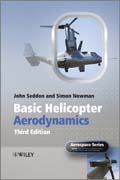
Basic Helicopter Aerodynamics, now in its third edition, is widely appreciated as an easily accessible, rounded introduction to the first principles of theaerodynamics of helicopter flight. Concentrating on the well-known Sikorsky configuration of single main rotor with tail rotor, the authors avoid the lengthy mathematical treatment of some textbooks, thereby making the material accessible to undergraduates as well as engineers looking for an introduction to the subject. Early chapters deal with the aerodynamics of the rotor in hover, vertical flight, forward flight and climb. Analysis of these motions is developed to the stage of obtaining the principal results for thrust, power and associated quantities. Later chapters turn to the characteristics of the overall helicopter, its performance, stability and control, and the important field of aerodynamic research is discussed, with some reference also to aerodynamic design practice. This third edition has been brought up to date with a complete newset of illustrations & imagery, as well as an accompanying website that contains all the calculation files used in the book, problems, solutions and powerpoint slides. The authors address the unique considerations applicable to rotorUAVs/ MAVs, and coverage of blade dynamics is expanded to include lagging andground resonance, and new material is included on blade tip design, flow characteristics surrounding the rotor in forward flight, tail rotors, and brown-out, blade sailing and shipborne operations. INDICE: About the Authors Preface to First Edition Preface to Second Edition Preface to Third Edition Notation Units Abbreviations 1 Introduction1.1 Looking BackReferences 2 Rotor in Vertical Flight: Momentum Theory and Wake Analysis2.1 Momentum Theory for Hover2.2 Non-dimensionalization2.3 Figure of Merit2.4 Axial Flight2.5 Momentum Theory for Vertical Climb2.6 Modelling the Streamtube2.7 Descent2.8 Wind Tunnel Test Results2.9 Complete Induced-Velocity Curve2.10 Summary Remarks on Momentum Theory2.11 Complexity of Real Wake2.12 Wake Analysis Methods2.13 Ground Effect2.14 BrownoutReferences 3 Rotor in Vertical Flight: Blade Element Theory3.1 Basic Method3.2 Thrust Approximations3.3 Non-uniform Inflow3.4 Ideal Twist3.5 Blade Mean Lift Coefficient3.6 Power Approximations3.7 Tip Loss3.8 Examples of Hover CharacteristicsReferences 4 Rotor Mechanisms for Forward Flight4.1 The Edgewise Rotor4.2 Flapping Motion4.3 Rotor Control4.4 Equivalence of Flapping and FeatheringReferences 5 Rotor Aerodynamics inForward Flight5.1 Momentum Theory5.2 Descending Forward Flight5.3 Wake Analysis5.4 Blade Element TheoryReferences 6 Aerodynamic Design6.1 Introductory6.2 Blade Section Design6.3 Blade Tip Shapes6.4 Tail Rotors 6.5 Parasite Drag6.6 Rear Fuselage Upsweep6.7 Higher Harmonic Control6.8 Aerodynamic Design ProcessReferences 7 Performance7.1 Introduction7.2 Hover and Vertical Flight7.3 ForwardLevel Flight7.4 Climb in Forward Flight7.5 Maximum Level Spread7.6 Rotor Limits Envelope7.7 Accurate Performance Prediction7.8 A World Speed Record7.9 Speculation on the Really Low-Drag Helicopter7.10 An Exercise in High-Altitude Operation7.11 Shipborne OperationReferences 8 Trim, Stability and Control8.1 Trim8.2 Treatment of Stability and Control8.3 Static Stability8.4 Dynamic Stability8.5 Hingeless Rotor8.6 Control8.7 AutostabilizationReferences 9 A Personal Look at the Future Appendix: Performance and Mission Calculation Index
- ISBN: 978-0-470-66501-5
- Editorial: John Wiley & Sons
- Encuadernacion: Cartoné
- Páginas: 264
- Fecha Publicación: 29/07/2011
- Nº Volúmenes: 1
- Idioma: Inglés
